Visual Behaviour and Cognitive Preferences of Users for Constituent Elements in Forest Landscape Spaces
Abstract
1. Introduction
1.1. Aesthetic Evaluation of Forest Landscape
1.2. Application of Eye-Tracking Technology in Landscape Assessment
1.3. Visual Behaviour Characteristics and Evaluation of Landscape Elements
- (1)
- Characteristics of and differences in visual behaviour for various elements in forest landscape spaces;
- (2)
- Characteristics of cognitive preferences for various elements in forest landscape spaces;
- (3)
- Relationship among element characteristics, cognitive preferences and visual behaviour.
2. Methods
2.1. Study Area
2.2. Collection of Experimental Materials
2.2.1. Photograph Acquisition
2.2.2. Eye-Movement Data Acquisition
2.2.3. Questionnaire Data Collection
2.3. Participants
2.4. Experimental Design
2.5. Selection of Indicators
2.5.1. Selection of Eye-Movement Indicators
2.5.2. Selection of Cognitive Perception Evaluation Indicators
2.6. Analysis and Statistics
- (1)
- One sample Kolmogorov–Smirnov test was used to determine whether the overall data were normally distributed and to determine the appropriate analysis and difference test methods.
- (2)
- After confirming that all data were normally distributed, we used a factor analysis to calculate the visual behaviour scores (VBSs) for each space.
- (3)
- One-way ANOVA was used to analyse the eye-movement behavioural differences among the participants when viewing various landscape elements in various types of spaces.
- (4)
- Spearman’s rho analysis was used to analyse whether there was a correlation between the characteristics of constituent elements, the participants’ visual behaviour and cognitive preferences for each AOI.
- (5)
- Multiple linear regression was used to establish the regression equation models of the characteristics of landscape elements, the participants’ visual behaviour, and cognitive preferences for different AOI types. We analysed how the three factors influenced each other with this model.
2.7. Composition Characteristics of Elements in Each Space
2.7.1. Classification of Constituent Elements
2.7.2. Quantification of the Characteristics of Constituent Elements
- (1)
- Complexity (CO): Xu pointed out that the complexity of an image can be measured by its colour complexity [53]. Therefore, we measured complexity by calculating the colour complexity of each element in the forest landscape space. The HSV colour model was adopted as the quantitative model [54]. The calculation formula is as follows:where C represents the complexity of an image, m represents the number of different colour types, i represents the kind of colour, n represents the number of pixels in one kind of colour, N represents the total number of pixels in an image, k represents the number of different connected domains of one colour in the image, j represents the kind of connected domain, and h represents the number of pixels of one connected domain.
- (2)
- Proportion of elements (POE): The proportion of elements is also an important attribute of landscapes [44]. In this study, the proportion of elements in the entire picture is the proportion of pixels in the entire picture. The calculation formula is as follows:where P represents the proportion of the element, E represents the total number of pixels in the image, and e represents the number of pixels of the element.
- (3)
- Visual behaviour score: The VBS associated with eye-movement indicators is representative and reflects people’s visual attention when viewing an AOI [18,31]. Factor analysis in SPSS 23.0 was used to reduce the dimension of each eye movement index and to obtain the variance contribution rate of each eye-movement index for each common factor. Then, the comprehensive score of each landscape element was calculated by a formula in which the variance contribution rate corresponding to each eye movement index collected was the weight. The calculation formula is as follows:where V is the VBS, n is the kind of eye-movement indicator, Fx is the factor score of an eye-movement indicator, and Vx is the variance contribution rate of this eye-movement indicator after factor analysis.
3. Results
3.1. Visual Behaviour Scores and Characteristics of Landscape Elements in Different Forest Spaces
3.2. Visual Behavioural Characteristics and Variation in Elements with Forest Landscape Space
3.3. Cognitive Preference Characteristics of Each Landscape Element in Various Forest Landscape Spaces
3.4. The Relationship among Visual Behaviour, Element Characteristics, and AOI Preferences
3.4.1. The Correlation between Element Characteristics, Cognitive Preference Indicators, and Eye-Movement Indicators
3.4.2. The Relationship among Element Characteristics, Cognitive Preferences, and Eye-Movement Behaviours
- (1)
- Influence of element characteristics on visual behaviour
- (2)
- Influence of element characteristics and eye-movement indicators on AOI preferences
- (3)
- Influence of element characteristics and AOI preferences on satisfaction
4. Discussion
4.1. With the Composition of Forest Landscape Spaces and the Different Ways of Combining Landscape Elements, Users’ Visual Behaviour in Relation to Landscape Elements also Differs
4.2. The Cognitive Preferences of Users for Each Element Vary with Forest Landscape Space
4.3. Interactive Influence among Element Characteristics, Visual Behaviour, and Cognitive Preferences
4.4. Limitations
5. Conclusions and Suggestions
5.1. Conclusions
- (1)
- Visual behaviour towards various elements is influenced by the overall spatial composition. With changes in the composition of a forest landscape space and different ways of combining landscape elements, visual behaviour towards landscape elements also differs. People are more likely to pay attention to landscape elements near the vanishing point of sight or apparent horizon.
- (2)
- In landscape spaces, people tend to shift their attention. At first, attention is easily attracted by highly fascinating landscape elements, but more time will be spent on less fascinating landscape elements.
- (3)
- Element characteristics significantly affect visual behaviour and cognitive preferences.
- (4)
- It takes people more time to recognize elements with high complexity and proportion. However, this does not mean that people prefer this kind of element, and people may reduce their satisfaction evaluations of a whole space because of the complex colour. The elements that people prefer at first sight usually account for a large proportion and low complexity. At the same time, judging from the influence of element characteristics on satisfaction, the more landscape elements with large proportions but simple forms there are, the higher the satisfaction with the landscape space.
5.2. Suggestions
Author Contributions
Funding
Data Availability Statement
Acknowledgments
Conflicts of Interest
References
- Gao, Y.; Zhang, T.; Zhang, W.; Meng, H.; Zhang, Z. Research on visual behavior characteristics and cognitive evaluation of different types of forest landscape spaces. Urban For. Urban Green. 2020, 54, 126788. [Google Scholar] [CrossRef]
- People’s Daily Online. 2021. Available online: http://sd.people.com.cn/BIG5/n2/2021/0118/c386907-34534285.html (accessed on 18 January 2021).
- Chinese Government Website. 2021. Available online: http://www.gov.cn/shuju/2021-01/19/content_5580910.htm (accessed on 19 January 2021).
- Arnberger, A. Recreation use of urban forests: An inter-area comparison. Urban For. Urban Green. 2006, 4, 135–144. [Google Scholar] [CrossRef]
- Arnberger, A.; Schneider, I.E.; Ebenberger, M.; Eder, R.; Venette, R.C.; Snyder, S.A.; Gobster, P.H.; Choi, A.; Cottrell, S. Emerald ash borer impacts on visual preferences for urban forest recreation settings. Urban For. Urban Green. 2017, 27, 235–245. [Google Scholar] [CrossRef]
- Buhyoff, G.J.; Wellman, J.D. Seasonality bias in landscape preference research. Leis. Sci. 1979, 2, 181–190. [Google Scholar] [CrossRef]
- Bulut, Z.; Yilmaz, H. Determination of waterscape beauties through visual quality assessment method. Environ. Monit. Assess. 2009, 154, 459–468. [Google Scholar] [CrossRef] [PubMed]
- Daniel, T.C. Whither scenic beauty? Visual landscape quality assessment in the 21st century. Landsc. Urban Plan. 2001, 54, 267–281. [Google Scholar] [CrossRef]
- Deng, S.; Yan, J.; Guan, Q.; Katoh, M. Short-term effects of thinning intensity on scenic beauty values of different stands. J. For. Res. 2013, 18, 209–219. [Google Scholar] [CrossRef]
- Gong, L.; Zhang, Z.; Xu, C. Developing a Quality Assessment Index System for Scenic Forest Management: A Case Study from Xishan Mountain, Suburban Beijing. Forests 2015, 6, 225–243. [Google Scholar] [CrossRef]
- Litton, R.B. Visual vulnerability of forest landscapes. J. For. 1974, 72, 392–397. [Google Scholar] [CrossRef]
- Schroeder, H.; Daniel, T.C. Progress in Predicting the Perceived Scenic Beauty of Forest Landscapes. For. Sci. 1981, 27, 71–80. [Google Scholar] [CrossRef]
- White, M.P.; Cracknell, D.; Corcoran, A.; Jenkinson, G.; Depledge, M.H. Do Preferences for Waterscapes Persist in Inclement Weather and Extend to Sub-aquatic Scenes? Landsc. Res. 2013, 39, 339–358. [Google Scholar] [CrossRef]
- Gundersen, V.; Stange, E.; Kaltenborn, B.; Vistad, O. Public visual preferences for dead wood in natural boreal forests: The effects of added information. Landsc. Urban Plan. 2017, 158, 12–24. [Google Scholar] [CrossRef]
- Van der Wal, R.; Miller, D.; Irvine, J.; Fiorini, S.; Amar, A.; Yearley, S.; Gill, R.; Dandy, N. The influence of information provision on people’s landscape preferences: A case study on understorey vegetation of deer-browsed woodlands. Landsc. Urban Plan. 2014, 124, 129–139. [Google Scholar] [CrossRef]
- Zhang, Z.; Qie, G.; Wang, C.; Jiang, S.; Li, X.; Li, M. Application of eye-tracking assistive technology in forest landscape evaluation. World For. Res. 2017, 30, 19–23. (In Chinese) [Google Scholar]
- Zhang, T.; Zhang, W.; Meng, H.; Zhang, Z. Analyzing Visitors’ Preferences and Evaluation of Satisfaction Based on Different Attributes, with Forest Trails in the Akasawa National Recreational Forest, Central Japan. Forests 2019, 10, 431. [Google Scholar] [CrossRef]
- Zhang, C.; Wang, H.; Wang, C. Visual Quality Evaluation and Distance Change Analysis of Urban Forest Landscape Based on Eye-movement. J. Chin. Urban For. 2020, 1, 6–12. (In Chinese) [Google Scholar]
- Habron, D. Visual perception of wild land in Scotland. Landsc. Urban Plan. 1998, 42, 45–56. [Google Scholar] [CrossRef]
- Dupont, L.; Antrop, M.; Van Eetvelde, V. Eye-tracking Analysis in Landscape Perception Research: Influence of Photograph Properties and Landscape Characteristics. Landsc. Res. 2013, 39, 417–432. [Google Scholar] [CrossRef]
- Rogge, E.; Dessein, J.; Gulinck, H. Stakeholders perception of attitudes towards major landscape changes held by the public: The case of greenhouse clusters in Flanders. Land Use Policy 2011, 28, 334–342. [Google Scholar] [CrossRef]
- Amati, M.; Parmehr, E.G.; McCarthy, C.; Sita, J. How eye-catching are natural features when walking through a park? Eye-tracking responses to videos of walks. Urban For. Urban Green. 2018, 31, 67–78. [Google Scholar] [CrossRef]
- Li, J.; Zhang, Z.; Jing, F.; Gao, J.; Ma, J.; Shao, G.; Noel, S. An evaluation of urban green space in Shanghai, China, using eye tracking. Urban For. Urban Green. 2020, 56, 126903. [Google Scholar] [CrossRef]
- Nordh, H.; Hagerhall, C.M.; Holmqvist, K. Tracking Restorative Components: Patterns in Eye Movements as a Consequence of a Restorative Rating Task. Landsc. Res. 2013, 38, 101–116. [Google Scholar] [CrossRef]
- Cottet, M.; Vaudor, L.; Tronchère, H.; Roux-Michollet, D.; Augendre, M.; Brault, V. Using gaze behavior to gain insights into the impacts of naturalness on city dwellers’ perceptions and valuation of a landscape. J. Environ. Psychol. 2018, 60, 9–20. [Google Scholar] [CrossRef]
- Lisińska-Kuśnierz, M.; Krupa, M. Suitability of Eye Tracking in Assessing the Visual Perception of Architecture—A Case Study Concerning Selected Projects Located in Cologne. Buildings 2020, 10, 20. [Google Scholar] [CrossRef]
- Shao, H. Landscape Quality Evaluation of Coal Mining Collapsed Land Based on Eye-Movement Analysis: A Case Study of Xuzhou City. Master’s Thesis, China University of Mining and Technology, Beijing, China, 2018. (In Chinese). [Google Scholar]
- Wang, M. Research on the Eye Analysis Techniques Used in the Visual Quality Evaluation of Landscape: A Case Study of the Landscape of Danxia Landform, Sunan, Gansu. Master’s Thesis, Nanjing University, Nanjing, China, 2011. (In Chinese). [Google Scholar]
- Zeng, X.Y. A Dissertation Submitted in Partial Fulfillment of the Requirements for the Degree of. Master of Landscape Architecture. Master’s Thesis, Huazhong University of Science and Technology, Wuhan, China, 2017. (In Chinese). [Google Scholar]
- Franěk, M.; Petružálek, J.; Šefara, D. Eye-movements in viewing urban images and natural images in diverse vegetation periods. Urban For. Urban Green. 2019, 46, 126477. [Google Scholar] [CrossRef]
- Dupont, L.; Antrop, M.; Van Eetvelde, V. Does landscape related expertise influence the visual perception of landscape photographs? Implications for participatory landscape planning and management. Landsc. Urban Plan. 2015, 141, 68–77. [Google Scholar] [CrossRef]
- Sun, L.; Shao, H.; Li, S.; Huang, X.; Yang, W. Integrated Application of Eye Movement Analysis and Beauty Estimation in the Visual Landscape Quality Estimation of Urban Waterfront Park. Int. J. Pattern Recognit. Artif. Intell. 2018, 32, 1856010. [Google Scholar] [CrossRef]
- Huang, A.S.-H.; Lin, Y.-J. The effect of landscape colour, complexity and preference on viewing behaviour. Landsc. Res. 2019, 45, 214–227. [Google Scholar] [CrossRef]
- Hands, D.E.; Brown, R. Enhancing visual preference of ecological rehabilitation sites. Landsc. Urban Plan. 2002, 58, 57–70. [Google Scholar] [CrossRef]
- Glaholt, M.G.; Wu, M.C.; Reingold, E.M. Predicting Preference from Fixations. PsychNology. J. 2009, 7, 141–158. [Google Scholar] [CrossRef]
- Guo, S.; Zhao, N.; Zhang, J.; Xue, T.; Liu, P.; Xu, S.; Xu, D. Landscape visual quality assessment based on eye-movement: College student eye-tracking experiments on tourism landscape pictures. Resour. Sci. 2017, 39, 1137–1147. (In Chinese) [Google Scholar]
- Kim, M.; Kang, Y.; Abu Bakar, S. A nightscape preference study using eye-movement analysis. Int. J. Sustain. Trop. Des. Res. Pract. 2013, 6, 85–99. [Google Scholar]
- Berto, R.; Massaccesi, S.; Pasini, M. Do eye movements measured across high and low fascination photographs differ? Addressing Kaplan’s fascination hypothesis. J. Environ. Psychol. 2008, 28, 185–191. [Google Scholar] [CrossRef]
- Rubin, E. Visuell Wahrgenommene Figuren; Glydenalske Boghandel: Kobenhaven, Denmark, 1921. [Google Scholar]
- Zhang, T.; Luo, T.; Gan, Y.; Qiu, Q. Effects of visual characteristics of landscape elements on perceptual priority. Res. Environ. Sci. 2012, 25, 297–303. (In Chinese) [Google Scholar]
- Rahnema, S.; Sedaghathoor, S.; Allahyari, M.S.; Damalas, C.A.; El Bilali, H. Preferences and emotion perceptions of ornamental plant species for green space designing among urban park users in Iran. Urban For. Urban Green. 2019, 39, 98–108. [Google Scholar] [CrossRef]
- Khachatryan, H.; Rihn, A.; Hansen, G.; Clem, T. Landscape Aesthetics and Maintenance Perceptions: Assessing the Relationship between Homeowners’ Visual Attention and Landscape Care Knowledge. Land Use Policy 2020, 95, 104645. [Google Scholar] [CrossRef]
- Dupont, L.; Ooms, K.; Antrop, M.; Van Eetvelde, V. Comparing saliency maps and eye-tracking focus maps: The potential use in visual impact assessment based on landscape photographs. Landsc. Urban Plan. 2016, 148, 17–26. [Google Scholar] [CrossRef]
- De Lucio, J.; Mohamadian, M.; Ruiz, J.; Banayas, J.; Bernaldez, F. Visual landscape exploration as revealed by eye movement tracking. Landsc. Urban Plan. 1996, 34, 135–142. [Google Scholar] [CrossRef]
- Sevenant, M.; Antrop, M. Landscape Representation Validity: A Comparison between On-site Observations and Photographs with Different Angles of View. Landsc. Res. 2011, 36, 363–385. [Google Scholar] [CrossRef]
- Lappi, O. Eye Tracking in the Wild: The Good, the Bad and the Ugly. J. Eye Mov. Res. 2015, 8, 1–21. [Google Scholar] [CrossRef]
- Wu, X.; Chen, S.; Zhao, R. Analysis of impact factors on forest park passenger flow based on baidu index. For. Resour. Manag. 2017, 1, 27. (In Chinese) [Google Scholar]
- Sui, X.; Gao, M.; Xiang, H.W. (Eds.) Eye-Movement Theory and Empirical Research in Visual Cognition; Beijing-Science Press: Beijing, China, 2018. (In Chinese) [Google Scholar]
- Jin, H.; Murakawa, S.; Nishina, D. Study on recognition and fixation behavior for river-landscape by the subjects of Chinese, Japanese and European. J. Archit. Plan. 2002, 67, 71–78. [Google Scholar] [CrossRef][Green Version]
- Lin, Y.; Ye, X. Landscape elements of Chinese classical gardens. Mod. Gard. 2014, 14, 127. (In Chinese) [Google Scholar]
- Liu, Y.; Hu, M.; Zhao, B. Audio-visual interactive evaluation of the forest landscape based on eye-tracking experiments. Urban For. Urban Green. 2019, 46, 126476. [Google Scholar] [CrossRef]
- Yukio, N. Urban landscape planning: Methods and practices of landscape control in Europe and America. Urban Plan. J. 2005, 3, 35. (In Chinese) [Google Scholar]
- Xu, S. Research on Image Complexity Based on Color Feature. Master’s Thesis, Henan University, Kaifeng, China, 2016. [Google Scholar]
- Lu, S.; Wang, B. An image retrieval algorithm based on improved color histogram. J. Phys. Conf. Ser. 2019, 1176, 022039. [Google Scholar] [CrossRef]
- Edelsbrunner, H.; Seidel, R. Voronoi diagrams and arrangements. Discret. Comput. Geom. 1986, 1, 25–44. [Google Scholar] [CrossRef]
- Liu, M.; Nijhuis, S. Mapping landscape spaces: Methods for understanding spatial-visual characteristics in landscape design. Environ. Impact Assess. Rev. 2020, 82, 106376. [Google Scholar] [CrossRef]
- Nordh, H.; Hartig, T.; Hagerhall, C.; Fry, G. Components of small urban parks that predict the possibility for restoration. Urban For. Urban Green. 2009, 8, 225–235. [Google Scholar] [CrossRef]
- Yan, G.L.; Bai, X.J. General Introduction to the Eye Movement Research: A Magic Science to Explore the Mystery of the Window on Mind; Beijing-Science Press: Beijing, China, 2012. (In Chinese) [Google Scholar]
- Swap, W.C. Interpersonal Attraction and Repeated Exposure to Rewarders and Punishers. Pers. Soc. Psychol. Bull. 1977, 3, 248–251. [Google Scholar] [CrossRef]
- Liu, Y.; Hu, M.; Zhao, B. Interactions between forest landscape elements and eye movement behavior under audio-visual integrated conditions. J. For. Res. 2019, 25, 21–30. [Google Scholar] [CrossRef]
- Berg, A.E.V.D.; Joye, Y.; Koole, S.L. Why viewing nature is more fascinating and restorative than viewing buildings: A closer look at perceived complexity. Urban For. Urban Green. 2016, 20, 397–401. [Google Scholar] [CrossRef]
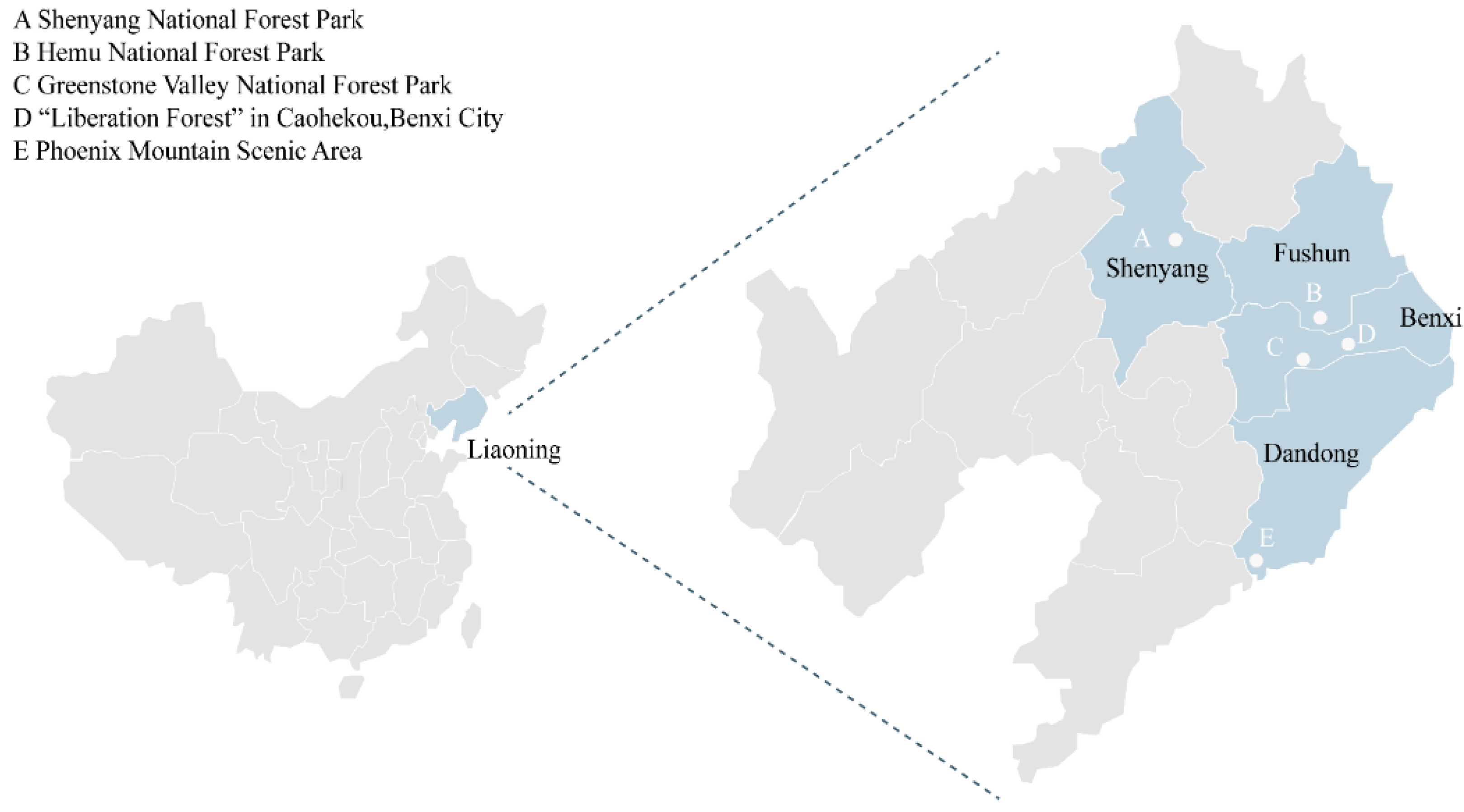
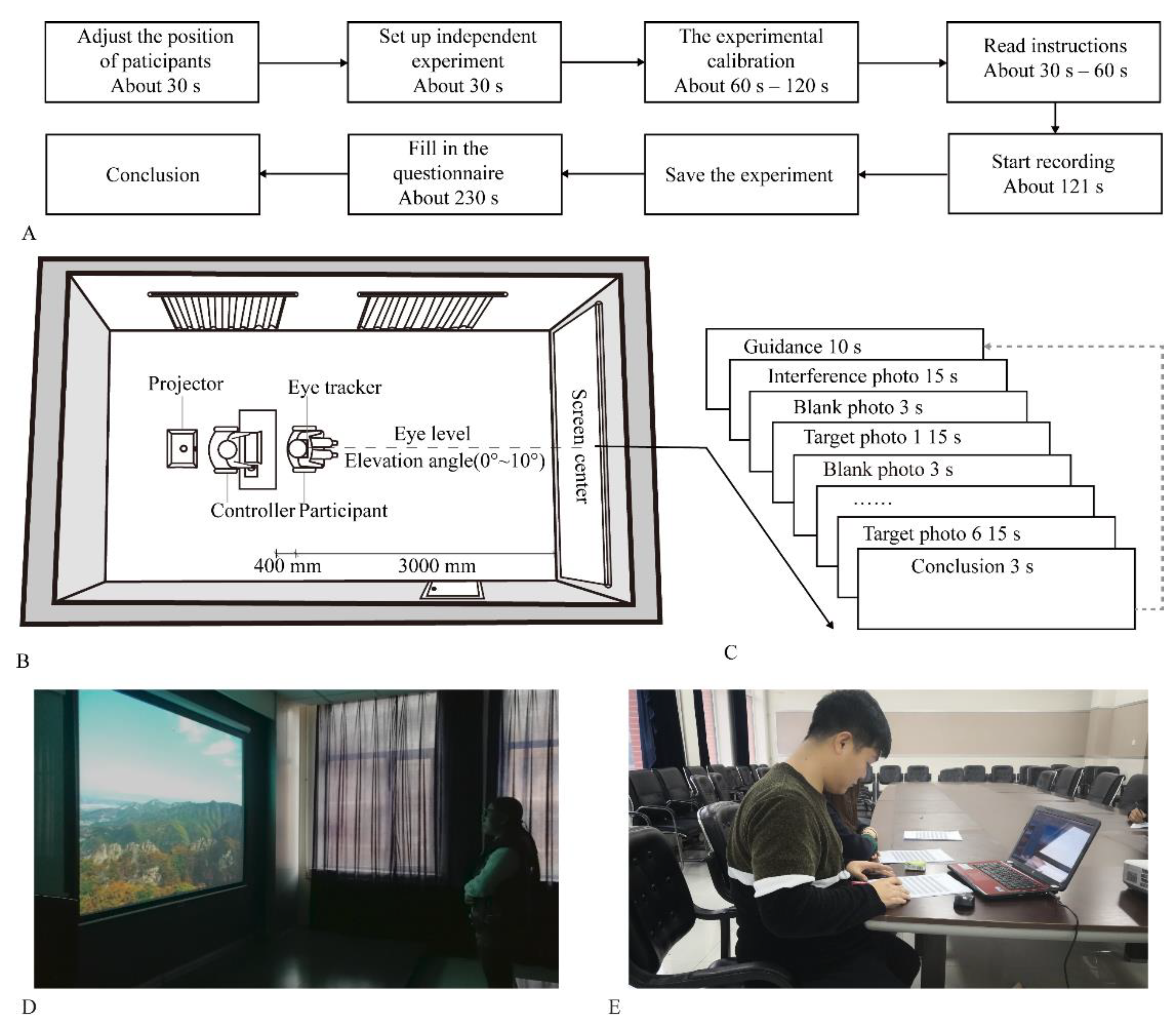
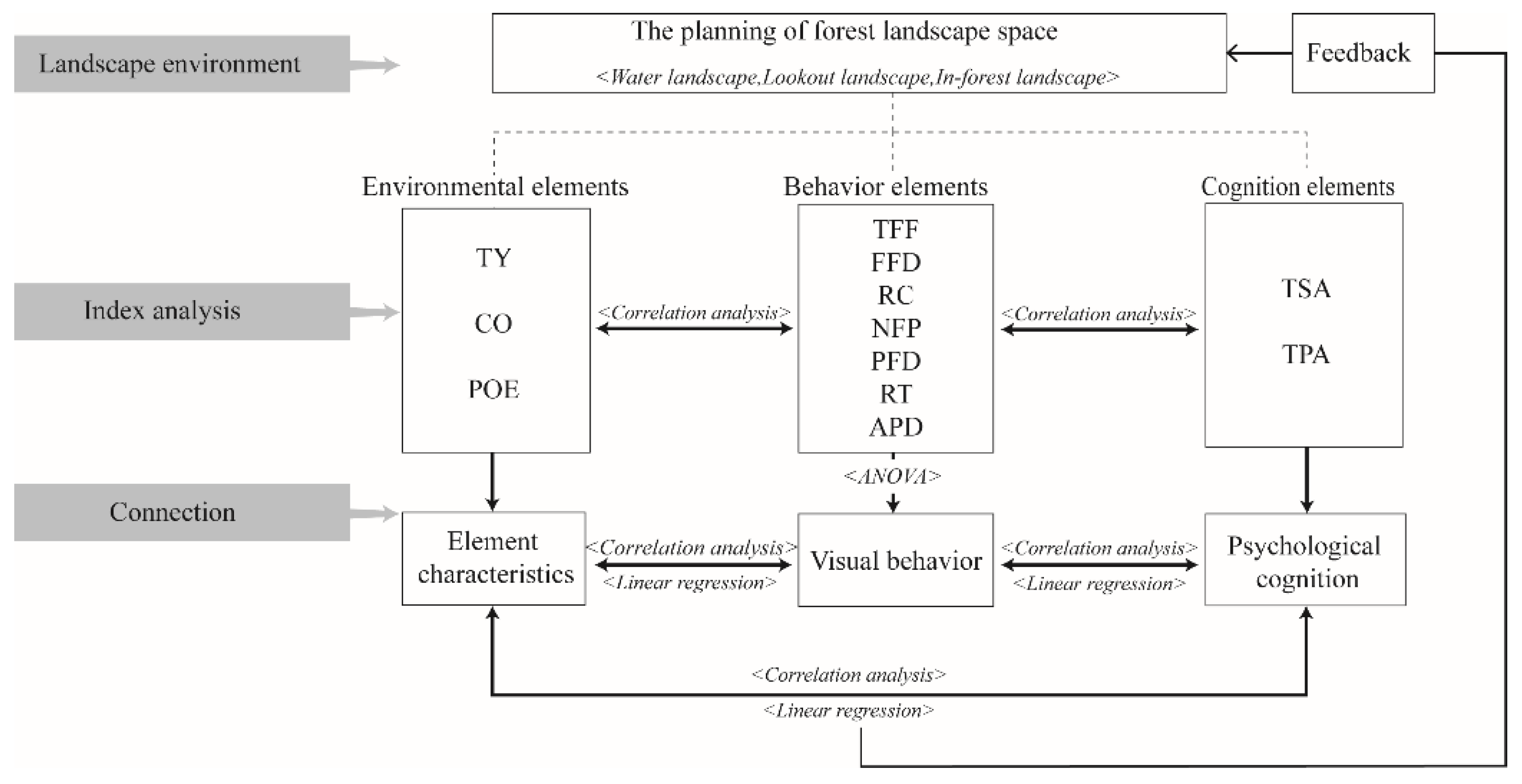
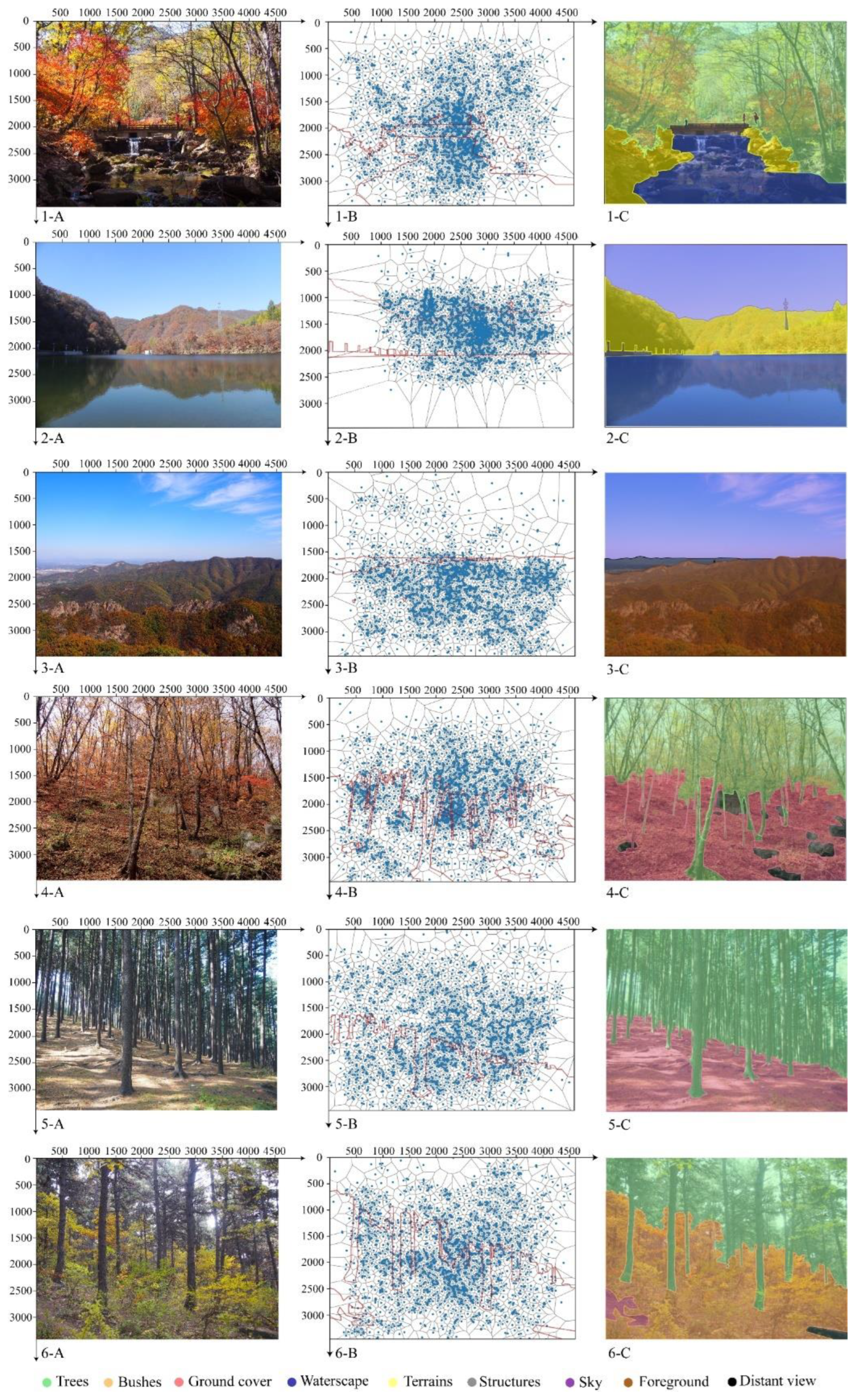

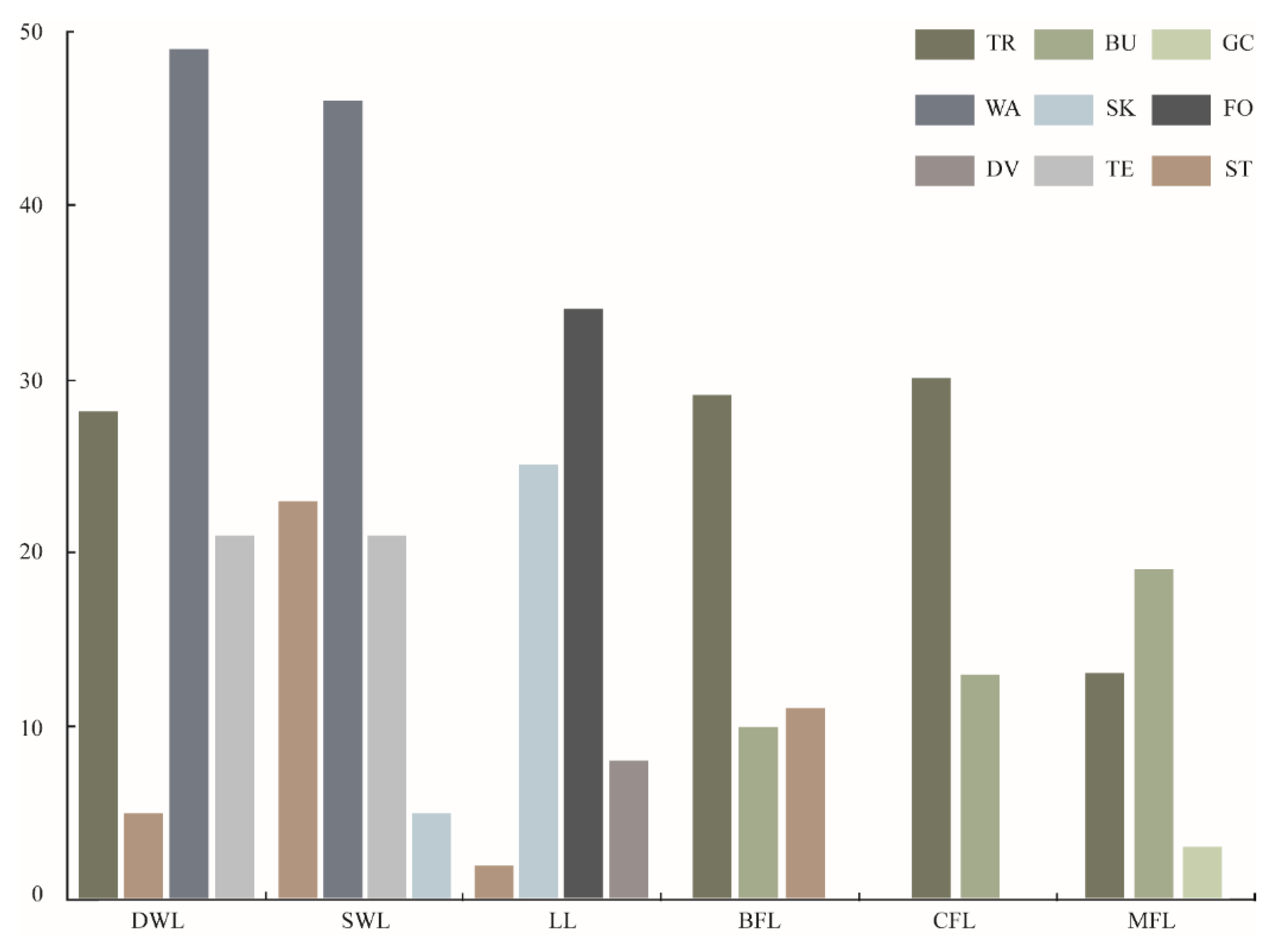

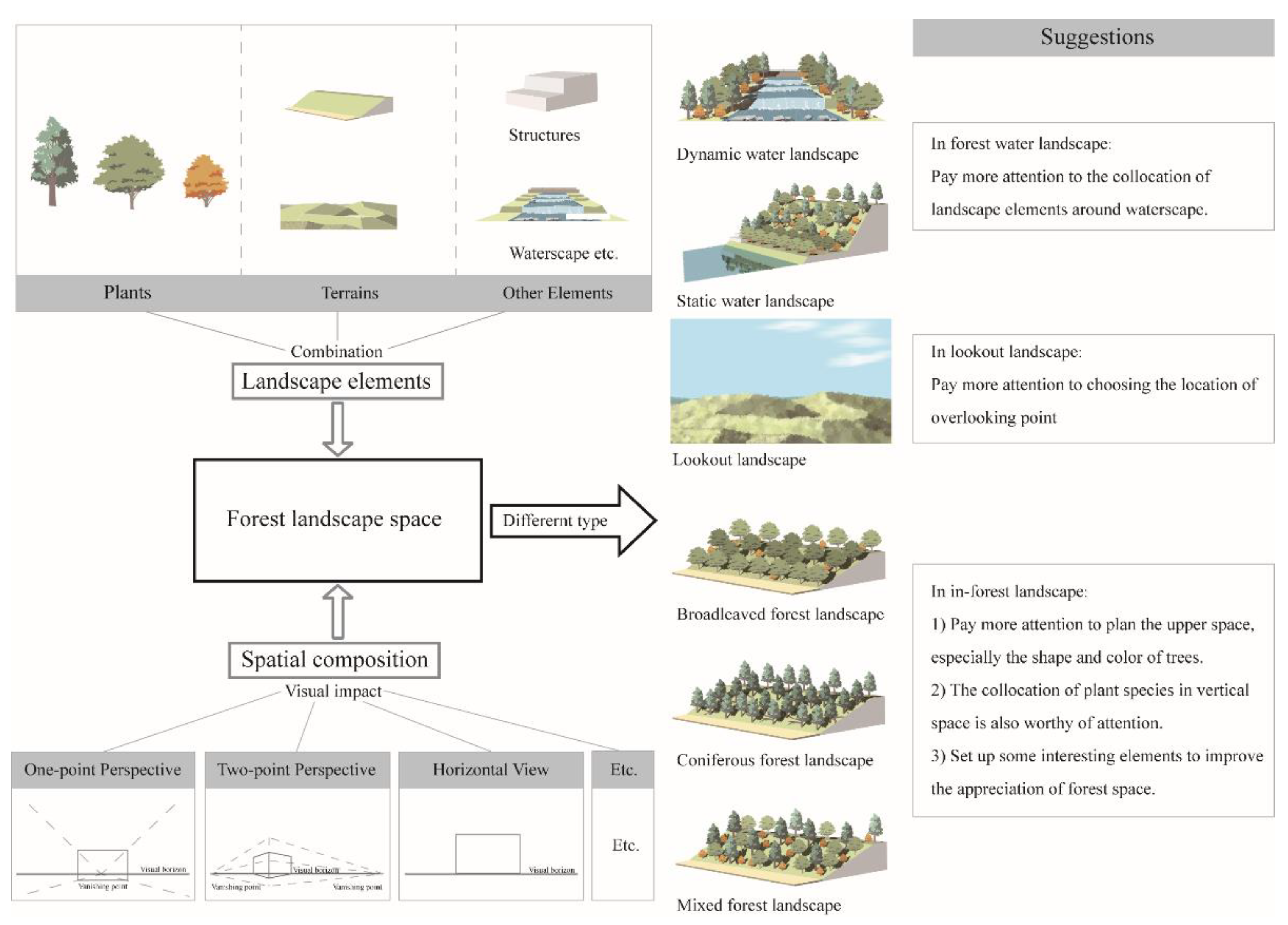
| Eye-Movement Indexes | Abbreviation | Significance |
|---|---|---|
| Time to first fixation/(ms) | TFF | Refers to the time point of first looking at an AOI when viewing a picture, reflecting how quickly the participant is attracted to a certain AOI. |
| First fixation duration/(ms) | FFD | Refers to the duration of the first fixation on the AOI, which best reflects the early processing state when viewing pictures. |
| Regression count/(count) | RC | Refers to the number of times that the AOI was viewed again after the first gaze, which reflects the participant’s reprocessing of the previous picture information. |
| Number of fixation points/(count) | NFP | Refers to the total number of gaze points in the AOI, effectively reflecting the cognitive processing load of or degree of interest in the AOI; AOIs with greater cognitive load or more interest have more viewing points. |
| Percentage of fixation duration/(%) | PFD | Refers to the ratio of the total fixation time on the AOI to the total fixation time on the whole picture and is an effective index of fixation on the region of interest accounting for the total fixation process. |
| Regression time/(ms) | RT | Refers to the sum of all gaze time spent looking back to the current AOI and reflects the postprocessing of the picture. |
| Average pupil diameter/(mm) | APD | Refers to the average pupil diameter while viewing the AOI, reflecting the cognitive processing degree and cognitive load of the participant. |
| Cognitive Preference Indexes | Abbreviation | Significance |
|---|---|---|
| The satisfaction | TSA | How satisfied are you with this landscape |
| The preferences of AOI | TPA | What are your favourite landscape elements |
| Type of Landscape Space | Construction Elements of the Space |
|---|---|
| Dynamic water landscape | Trees, terrain, waterscape, structures |
| Static water landscape | Sky, terrain, waterscape, structures |
| Lookout landscape | Sky, foreground, distant view, structures |
| Broadleaved forest landscape | Trees, ground cover, structures |
| Coniferous forest landscape | Trees, ground cover |
| Mixed forest landscape | Trees, bushes, ground cover, structures |
| Spatial Type | Type of AOI | Complexity | Proportion | Visual Behaviour Score |
|---|---|---|---|---|
| DWL | Trees | 0.922 | 65.400 | 0.742 |
| Terrains | 0.219 | 11.400 | −0.511 | |
| Waterscape | 0.303 | 20.600 | 0.269 | |
| Structures | 0.053 | 2.600 | −0.500 | |
| SWL | Terrains | 0.275 | 24.800 | 0.341 |
| Waterscape | 0.352 | 39.600 | 0.212 | |
| Structures | 0.027 | 1.200 | −0.339 | |
| Sky | 0.022 | 34.400 | −0.215 | |
| LL | Structures | 0.001 | 2.600 | −0.020 |
| Sky | 0.001 | 46.900 | −0.297 | |
| Foreground | 0.751 | 34.400 | 0.700 | |
| Distant view | 0.010 | 8.100 | 0.160 | |
| BFL | Trees | 0.722 | 52.900 | 0.359 |
| Ground cover | 0.727 | 41.300 | 0.453 | |
| Structures | 0.177 | 6.700 | −0.813 | |
| CFL | Trees | 0.794 | 66.500 | 0.322 |
| Ground cover | 0.470 | 33.500 | −0.322 | |
| MFL | Trees | 0.647 | 49.200 | 0.556 |
| Bushes | 1.309 | 48.400 | 0.838 | |
| Ground cover | 0.096 | 1.700 | −0.703 | |
| Structures | 0.023 | 0.700 | −0.695 |
| TFF | FFD | RC | NFP | PFD | RT | APD | TPA | TSA | ||
|---|---|---|---|---|---|---|---|---|---|---|
| Spearman’s rho | CO | 0.020 | 0.430 ** | 0.639 ** | 0.735 ** | 0.557 ** | 0.715 ** | 0.435 ** | 0.259 ** | −0.148 ** |
| POE | −0.031 | 0.406 ** | 0.565 ** | 0.658 ** | 0.667 ** | 0.635 ** | 0.418 ** | 0.309 ** | −0.088 ** | |
| TSA | 0.072 * | 0.012 | −0.133 ** | −0.057 | −0.027 | −0.077 ** | −0.059 | 0.175 ** | 1.000 | |
| TPA | 0.049 | 0.212 ** | 0.215 ** | 0.300 ** | 0.318 ** | 0.264 ** | 0.228 ** | 1.000 | 0.175 ** | |
| N | 1110 | 1110 | 1110 | 1110 | 1110 | 1110 | 1110 | 1110 | 1110 | |
Publisher’s Note: MDPI stays neutral with regard to jurisdictional claims in published maps and institutional affiliations. |
© 2022 by the authors. Licensee MDPI, Basel, Switzerland. This article is an open access article distributed under the terms and conditions of the Creative Commons Attribution (CC BY) license (https://creativecommons.org/licenses/by/4.0/).
Share and Cite
Zhou, S.; Gao, Y.; Zhang, Z.; Zhang, W.; Meng, H.; Zhang, T. Visual Behaviour and Cognitive Preferences of Users for Constituent Elements in Forest Landscape Spaces. Forests 2022, 13, 47. https://doi.org/10.3390/f13010047
Zhou S, Gao Y, Zhang Z, Zhang W, Meng H, Zhang T. Visual Behaviour and Cognitive Preferences of Users for Constituent Elements in Forest Landscape Spaces. Forests. 2022; 13(1):47. https://doi.org/10.3390/f13010047
Chicago/Turabian StyleZhou, Sitong, Yu Gao, Zhi Zhang, Weikang Zhang, Huan Meng, and Tong Zhang. 2022. "Visual Behaviour and Cognitive Preferences of Users for Constituent Elements in Forest Landscape Spaces" Forests 13, no. 1: 47. https://doi.org/10.3390/f13010047
APA StyleZhou, S., Gao, Y., Zhang, Z., Zhang, W., Meng, H., & Zhang, T. (2022). Visual Behaviour and Cognitive Preferences of Users for Constituent Elements in Forest Landscape Spaces. Forests, 13(1), 47. https://doi.org/10.3390/f13010047






